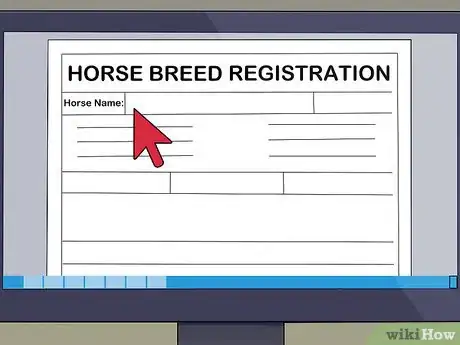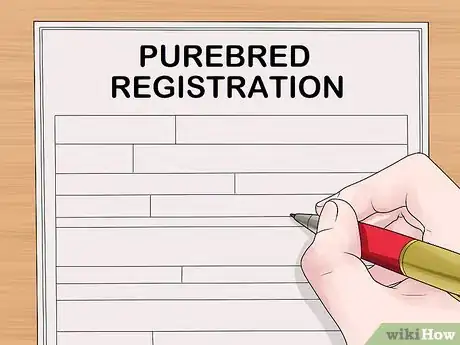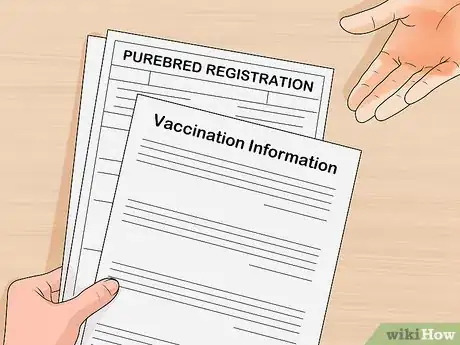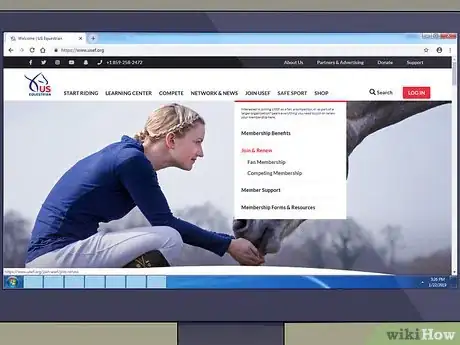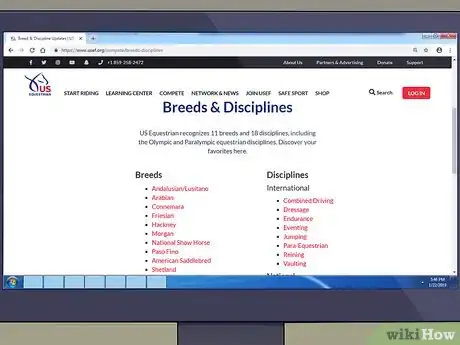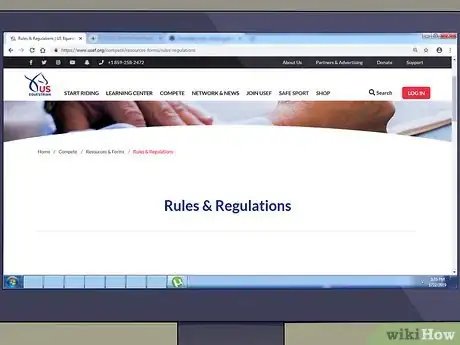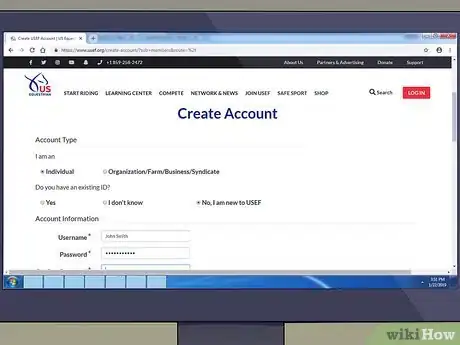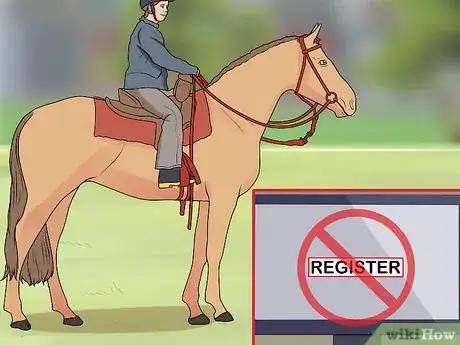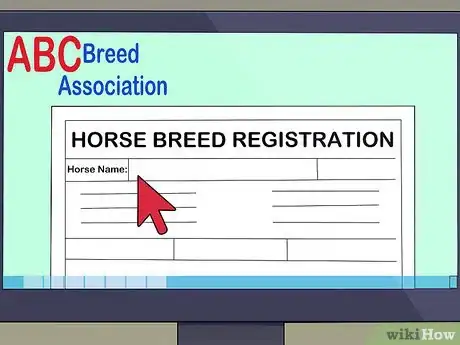This article was co-authored by Alana Silverman. Alana Silverman is a Certified EAGALA (Equine Assisted Growth and Learning Association) Equine Specialist and the Assistant Manager of Paddock Riding Club, a 200-horse premier equestrian facility based in Los Angeles, California. Alana has over 25 years of experience caring for and riding horses and specializes in English riding and riding instruction. She has a BA in Psychology from the University of Arizona.
This article has been viewed 53,668 times.
Types of horse registration can vary, as various associations and federations maintain different registries. These organizations vary in terms of the rules and benefits of membership. Some breed specific horse shows, for instance, require registration in a specific breed association. Many equestrian events also require registration in certain organizations. Most organizations require that you provide proof of ownership, and that your horse meets certain criteria.[1] [2]
Steps
Registering Your Horse in a Specific Breed Association
-
1Identify the breed of your horse. If you plan to show or compete with your horse, you likely know what breed they are. A horse trainer or veterinarian that works on different types of horses can help you identify the likely breed if you’re unsure. Visit different breed association websites to read about the characteristics of different breeds. These websites will contain guidelines, specifications and rules about registering a horse for that specific breed. Other general breed-identification websites also list the significant characteristics of different breeds.
-
2Contact the corresponding breed association. Reach out to the breed association you’re considering to ask any questions you may have. The association will provide you with any forms you’ll need to complete the application process. They may be able to point you towards another organization if there is a better fit for your horse elsewhere. [3]
- There are a variety of organizations you can register a horse with, like the United States Equestrian Federation (USEF), the International Federation for Equestrian Sports (FEI), and the United States Hunter Jumper Association (USHJA). There are also breed-specific associations, which require a physical exam in order to register.[4]
Advertisement -
3Fill out a registration application. For almost all breed associations, fill out a written or online application. Follow the specific instructions on the breed association’s website. Provide your horse’s name, as well as information about the horse’s sire and dam. You may also need to become a member of the association yourself.[5]
- Usually, you’ll save time and money by submitting the application online. Some associations still allow or prefer paper mail. Their website will contain this information.
- You may have to make an online account to navigate an association’s application portal.
-
4Submit photos with the application. Some horse breeds are confirmed by the physical appearance of the horse. Include several clear photographs of your horse with the application. Be sure that the photos show any swirls, brands, belly splashes, or other significant markings.[6]
- One common type of required photo is a silhouette, which may need to be verified by your vet.
- Wash the horse before taking photos to use in your application. Make sure the horse is dry, and that their coat is clearly visible in each photo.
-
5Apply for purebred registration. Purebred registration can greatly increase the value of your horse and make them eligible for exclusive shows and competitions. These applications will require more paperwork regarding the horse’s genetic lineage. You will also likely need to provide a DNA sample.[7]
- For instance, the Arabian Horse Association will provide you with a DNA kit and instructions once you’ve submit your application and application fee.
-
6Submit all necessary paperwork. Certain applications or scenarios may require additional paperwork. If your horse has a microchip, include the corresponding identification number. If your horse has a passport, include this information as well. Finally, include any vaccination information in your application materials.[8] [9]
- If you’re registering a foal and do not own the foal’s dam, you will likely have to fill out additional paperwork to verify this information.
- You’ll also have to include additional information if you hope to register as the foal’s breeder.
-
7Pay the application fee. Include payment of the application fee when submitting your application materials. These fees will vary, and some associations may require recurring fees. Further, fees may depend on factors unique to the horse, such as how the foal was conceived.[10] [11]
- There may also be a fee for you to register as a member of an association too. Fees will range from $25 dollars to more than $100.
Joining the US Equestrian Federation
-
1Join the USEF to compete in equestrian sports. The United States Equestrian Federation is the national governing body that regulates several equestrian disciplines for several different horse breeds. The USEF is the largest organization in equestrian sports of this kind.[12] Register your horse in the USEF if it is one of the 11 different breeds recognized by the organization and you plan to compete in one or more of 18 different disciplines regulated by the Federation.
-
2Ensure the USEF recognizes your horse’s breed. You may also want to register your horse in a specific breed association, though this may not be necessary. The breeds recognized by the USEF include: Andalusian / Lusitano, Arabian / Half-Arabian / Anglo-Arabian, Connemaras, Friesian, Hackney, Morgan, National Show Horse, Paso Fino, American Saddlebred, Shetland, and Welsh.[13]
-
3Consider the competitions the USEF regulates. Some of the regulations maintained by the USEF are internationally sanctioned. The USEF is the organization responsible for training and otherwise comparing many equestrian competitors for Olympic equestrian events. The specific international disciplines recognized by the USEF include Combined Driving, Dressage, Endurance, Eventing, Jumping, Para-Equestrian, Reining, and Vaulting. There are also several disciplines specific to the US that the Federation regulates.[14]
-
4Gain access to exclusive opportunities. Aside from access to over 2, 600 regulated competitions, membership in the USEF offers further benefits. Involvement with the organization can help you meet and network with others who share your interest in showing and competing with your horse. There are events and programs as well as other opportunities that are only accessible for members of the USEF.[15]
-
5Create an account on the USEF website. To join the USEF, you must make a “My USEF My Way” account on the organization’s website. Enter your basic information as prompted by the website. Your creation of an account will provide you with a USEF ID. There are several types of memberships available. The online portal will guide you to make the selection that’s best for you and your horse.[16]
- Contact a USEF customer service representative for help signing up for a membership.
- Use this account to register for specific events, programs, and more.
Considering Other Aspects of Registration
-
1Don’t register unless you need to. It’s only worth registering your horse for specific reasons. For instance, you have a horse you enjoy riding casually or work with, you likely don’t need to register them. Registrations fees can be substantial, and the process can be time-consuming. However, registering your horse makes it easier to put them on the market, and may even increase their value.[17]
- In short, if you hope to show or compete with your horse, or want to breed or sell your horse, register the horse in the appropriate registries. Forego registration if you don’t harbor any of these intentions.
-
2Register only with necessary organizations. While this article outlines the steps to take in order to register with a specific breed association, as well as a larger regulatory federation, you may not need to do both. If you want to compete in a specific event, contact the event organizers and ask them about the requirements to participate. Only highly formal, stylized, and exclusive events will require multiple types of registration.
- Whenever unsure about the necessity of registering your horse, ask a local horse trainer or veterinarian about whether you should do so.
-
3Think about your horse’s registered name. While you can call your horse whatever you want when speaking to them, registries try to ensure that no two horses have the same name. Many breed associations and other organizations will have specific rules about the name of your horse. These will include rules about spelling and punctuation. These rules comply with certain show and competition regulations.[18]
- You may want to find out about name requirement before submitting an application. Some breed associations will even require you to submit multiple potential names. This ensures one of the names is unique. The application may direct you to list names in order of your preference.
Community Q&A
-
QuestionMy horse has no papers, but I want to transport her. Is it necessary to have papers then?
 Community AnswerGenerally a horse will need veterinary paperwork to transport them over state lines; typical required paperwork is a current negative Coggins and a certificate of health. Transport into a different country could also require a quarantine. A horse does not need breed registration papers to be transported.
Community AnswerGenerally a horse will need veterinary paperwork to transport them over state lines; typical required paperwork is a current negative Coggins and a certificate of health. Transport into a different country could also require a quarantine. A horse does not need breed registration papers to be transported. -
QuestionAm I able to register a horse who is not a purebred?
 Community AnswerIn certain organizations, yes. For example, you can't register a grade horse into the AQHA, but if it has pinto/paint markings, you can register into the pinto/paint association.
Community AnswerIn certain organizations, yes. For example, you can't register a grade horse into the AQHA, but if it has pinto/paint markings, you can register into the pinto/paint association. -
QuestionCan I register a horse that is not a pure breed outside of the USA?
 Community AnswerIt depends on the registry. Most though, will require proof of the parents lineage and require that them to be a certain breed.
Community AnswerIt depends on the registry. Most though, will require proof of the parents lineage and require that them to be a certain breed.
References
- ↑ https://www.arabianhorses.org/registration/
- ↑ http://apha.com/wp-content/uploads/2016/07/registration-application2016.pdf
- ↑ http://apha.com/wp-content/uploads/2016/07/registration-application2016.pdf
- ↑ Alana Silverman. Certified Horse Trainer. Expert Interview. 17 March 2020.
- ↑ https://www.arabianhorses.org/registration/
- ↑ https://www.arabianhorses.org/registration/
- ↑ https://www.arabianhorses.org/registration/
- ↑ https://www.arabianhorses.org/registration/
- ↑ http://apha.com/wp-content/uploads/2016/07/registration-application2016.pdf
- ↑ https://www.arabianhorses.org/registration/
- ↑ http://apha.com/wp-content/uploads/2016/07/registration-application2016.pdf
- ↑ https://www.usef.org/
- ↑ https://www.usef.org/filters/welcome.aspx
- ↑ https://www.usef.org/filters/welcome.aspx
- ↑ https://www.usef.org/filters/welcome.aspx
- ↑ https://www.usef.org/_AUAIFrames/login/default.aspx
- ↑ https://www.arabianhorses.org/registration/
- ↑ http://apha.com/wp-content/uploads/2016/07/registration-application2016.pdf
About This Article
To register your horse, contact the association for its breed to get an application form. If you don't know your horse's breed, you can ask a horse trainer or veterinarian to help identify it. Then, fill in all the details, and submit photos of your horse if required. If you're applying for purebred registration, you will probably need to provide a DNA sample too. You may also need to provide details of your horse's vaccination history, passport, and identification number if it has a microchip. Finally, pay any application fees that the organization charge and wait for your response. For more tips, like how to identify the breed of your horse, read on!



